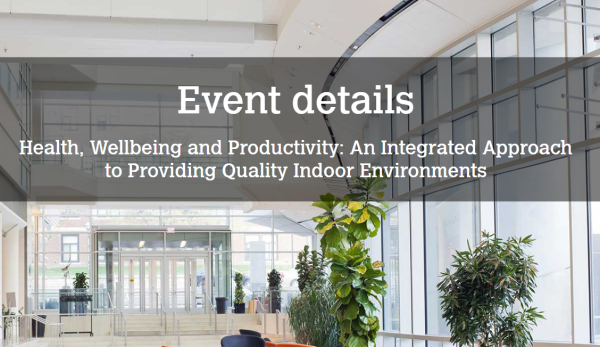Health, wellbeing and productivity: An integrated approach to providing quality indoor environments
People living in developed countries spend typically 90% or more of their time indoors and more susceptible individuals, such as the elderly, infants and those with pre-existing medical conditions, may spend almost all of their time indoors.
Poor housing conditions have been demonstrated to have adverse effects on occupants’ health and wellbeing with associated large-scale health costs. In the education and health care sectors, the quality of the indoor environment has been shown to affect the educational performance of students and the recovery rates of patients, respectively. In commercial environments, typically up to 90% of the operational costs to an organisation are associated with the staff, with the remaining 10% covering building rental and energy expenditure. The provision of good quality indoor environments in buildings is, therefore, essential for the health, comfort, wellbeing and also the productivity of the occupants.
Major building owners and specifiers are now increasingly demanding highperformance office buildings, recognising that those with high quality indoor environments can command higher rental incomes from improving staff health, wellbeing and productivity. However, though the benefits of healthier buildings are increasingly being recognised in this sector, there is still a general lack of understanding and knowledge of the issues involved and hence little guidance on how to achieve such healthy buildings across the whole of the built environment.
On Thursday 28th February 2019, BRE will be running ‘Health, Wellbeing and Productivity: An Integrated Approach to Providing Quality Indoor Environments’ – a conference which will concentrate on ways of providing and maintaining quality indoor environments in both domestic and non-domestic buildings.
It will focus primarily on the key factors – such as air quality, ventilation, lighting, and environmental noise – that must be considered in an integrated manner in order to provide good quality indoor environments. Leading speakers from BRE, industry and regulatory authorities will provide the latest information along with their views and experiences, and case study examples.
For further details of the speaker line-up and to book your place visit https://bregroup.com/hwpconference entering discount code EB20HWP at check-out for an early bird discount (only available until 21 December).
--BRE Buzz
[edit] Related articles on Designing Buildings Wiki
- Assessing health and wellbeing in buildings.
- BRE Buzz articles.
- BRE wellbeing research paper competition.
- Building related illness.
- Building use studies (BUS).
- Human comfort in buildings.
- Indoor air quality.
- Indoor environmental quality.
- Light pollution.
- Sick building syndrome.
- TG10 2016 At a glance, wellbeing.
- The full cost of poor housing.
- Thermal comfort and wellbeing.
- Wellbeing.
- Wellbeing and creativity in workplace design - case studies.
- WELL and BREEAM align.
- WELL Building Standard.
- What we know about wellbeing.
Featured articles and news
Latest Build UK Building Safety Regime explainer published
Key elements in one short, now updated document.
UKGBC launch the UK Climate Resilience Roadmap
First guidance of its kind on direct climate impacts for the built environment and how it can adapt.
CLC Health, Safety and Wellbeing Strategy 2025
Launched by the Minister for Industry to look at fatalities on site, improving mental health and other issues.
One of the most impressive Victorian architects. Book review.
Common Assessment Standard now with building safety
New CAS update now includes mandatory building safety questions.
RTPI leader to become new CIOB Chief Executive Officer
Dr Victoria Hills MRTPI, FICE to take over after Caroline Gumble’s departure.
Social and affordable housing, a long term plan for delivery
The “Delivering a Decade of Renewal for Social and Affordable Housing” strategy sets out future path.
A change to adoptive architecture
Effects of global weather warming on architectural detailing, material choice and human interaction.
The proposed publicly owned and backed subsidiary of Homes England, to facilitate new homes.
How big is the problem and what can we do to mitigate the effects?
Overheating guidance and tools for building designers
A number of cool guides to help with the heat.
The UK's Modern Industrial Strategy: A 10 year plan
Previous consultation criticism, current key elements and general support with some persisting reservations.
Building Safety Regulator reforms
New roles, new staff and a new fast track service pave the way for a single construction regulator.
Architectural Technologist CPDs and Communications
CIAT CPD… and how you can do it!
Cooling centres and cool spaces
Managing extreme heat in cities by directing the public to places for heat stress relief and water sources.
Winter gardens: A brief history and warm variations
Extending the season with glass in different forms and terms.
Restoring Great Yarmouth's Winter Gardens
Transforming one of the least sustainable constructions imaginable.
























